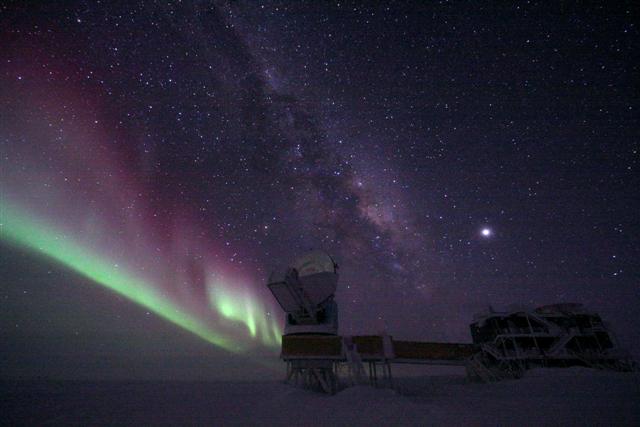Benign SpaceSouth Pole offers ideal location to observe the mysteries of the universePosted October 2, 2009
The South Pole “This is the most benign environment on Earth,” he said as we climbed into the narrow indoor cavity housing the mount that once supported a couple of telescopes that helped astronomers refine our understanding of the universe. “This is the most benign environment on Earth,” he repeated as we kicked at the miniature snowdrifts within the mammoth bowl-shaped telescope shield on the roof of that observatory. The South Pole, of course, is also “the harshest environment on Earth,” Holzapfel acknowledged, as we rested in the control room for the South Pole Telescope (SPT) The weather the last week of 2008 had been unseasonably mild. Holzapfel made his daily treks to the Dark Sector — the portion of the South Pole complex that prohibits errant electromagnetic signals, so as not to interfere with the telescopes — wearing running shoes and jeans. Temperatures didn’t dip lower than the minus single digits Fahrenheit all week, and once even peeped above zero to set a record high for the date. The participants in the traditional New Year’s Day group swimsuit photo at the ceremonial South Pole experienced only intense discomfort, not imminent hypothermia. And certainly many of the amenities at the new science station feel more like a corporate retreat than a remote outpost. Little things like lobster on Christmas can even spoil you. When I learned that video-chatting with my wife and kids was available for only nine hours a day, because the communications satellites are below the horizon for the other 15 hours, I knew how Scott felt. But when Holzapfel said “benign,” he wasn’t thinking of the relatively mild weather or the occasional luxurious living conditions. He was referring instead to the South Pole of global infamy, the one that comes with six months of darkness, 100-below temperatures, and a Michelin Man fashion sensibility. That’s the South Pole that indeed becomes the most conducive place on Earth to perform a certain kind of astronomy. Or, as astronomers like to say, if you want better observing conditions, you’d have to go into space. I had come to the Pole, courtesy of a grant from the National Science Foundation’s Antarctic Artists and Writers Program Although I don’t have a background in science, I write about science for a non-specialist audience. I try to use my initial ignorance and then my gradual learning process as a way to figure out how to present the necessary information to readers in a logical and accessible fashion. For this book, my topic is a mystery that many researchers feel might be the most significant and profound in science today: What comprises the vast majority of the universe? In studying galaxies (including our own Milky Way), astronomers have consistently found that galaxies seem to be rotating far too rapidly for their own good. From what we can see of the amount and distribution of the visible matter, the galaxies should be deeply unstable. They’re spinning so fast that they should be shedding stars and gas in every direction — unless there’s something else out there stabilizing them. Something we can’t see but is nevertheless exerting a gravitational influence on the matter we can see. Astronomers call this mysterious something “dark matter.” As for the kind of matter that makes up you, me, my laptop, Earth, planets, stars, and galaxies, it’s the exception in the universe, not the rule, a realization that has led some observers to call the discovery of dark matter “the ultimate Copernican revolution.”1 2 3 Next |



For USAP Participants |
For The Public |
For Researchers and EducatorsContact UsU.S. National Science FoundationOffice of Polar Programs Geosciences Directorate 2415 Eisenhower Avenue, Suite W7100 Alexandria, VA 22314 Sign up for the NSF Office of Polar Programs newsletter and events. Feedback Form |


